七年级下册 Module 11 Body language Unit 1 They touch noses!课件(29张PPT)
文档属性
| 名称 | 七年级下册 Module 11 Body language Unit 1 They touch noses!课件(29张PPT) |
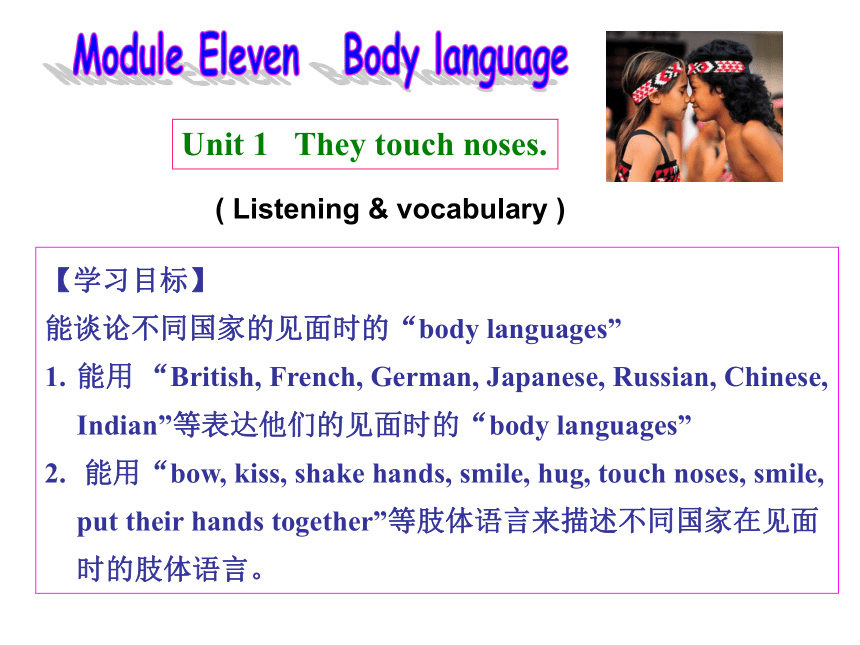
|
|
| 格式 | ppt | ||
| 文件大小 | 5.3MB | ||
| 资源类型 | 教案 | ||
| 版本资源 | 外研版 | ||
| 科目 | 英语 | ||
| 更新时间 | 2023-05-19 19:03:08 | ||
图片预览


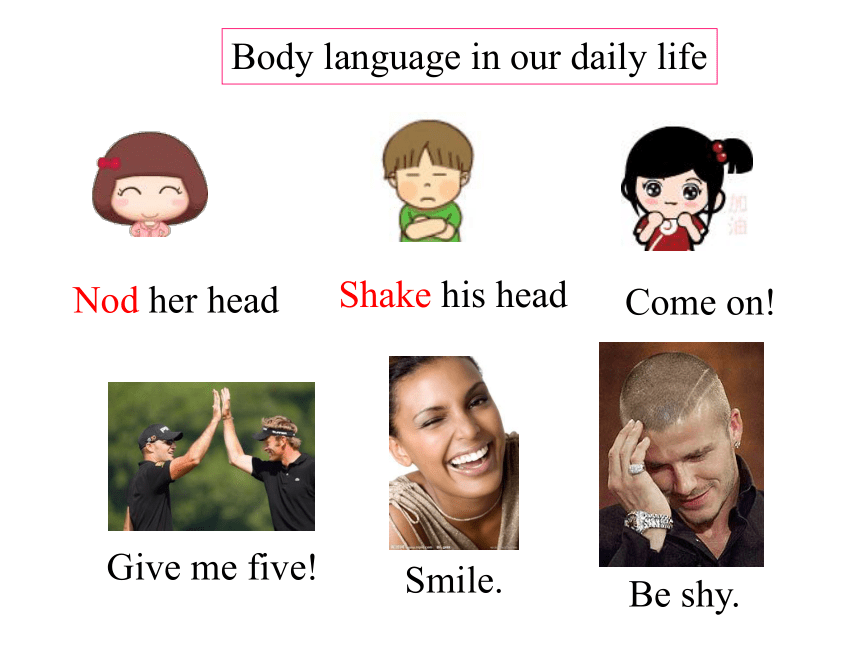
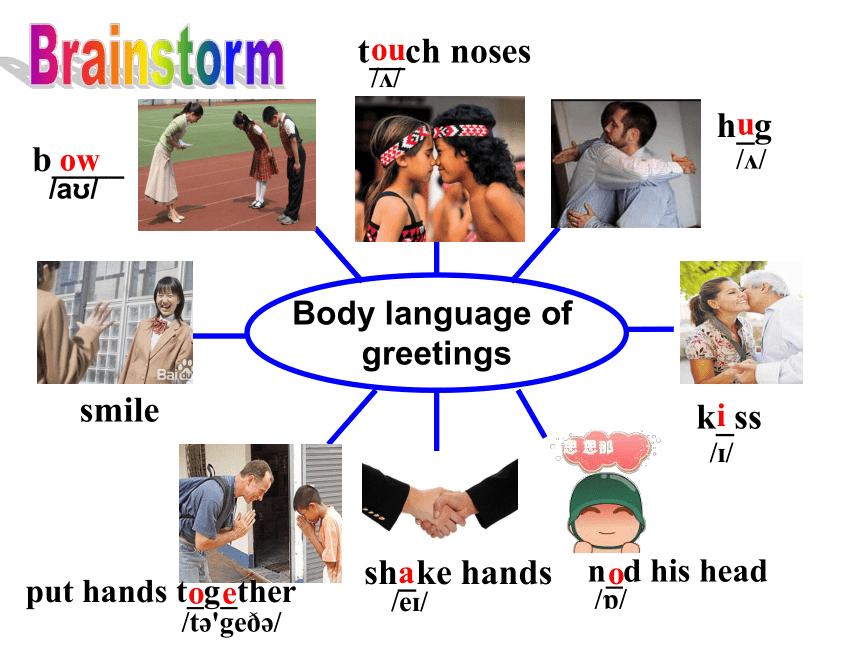
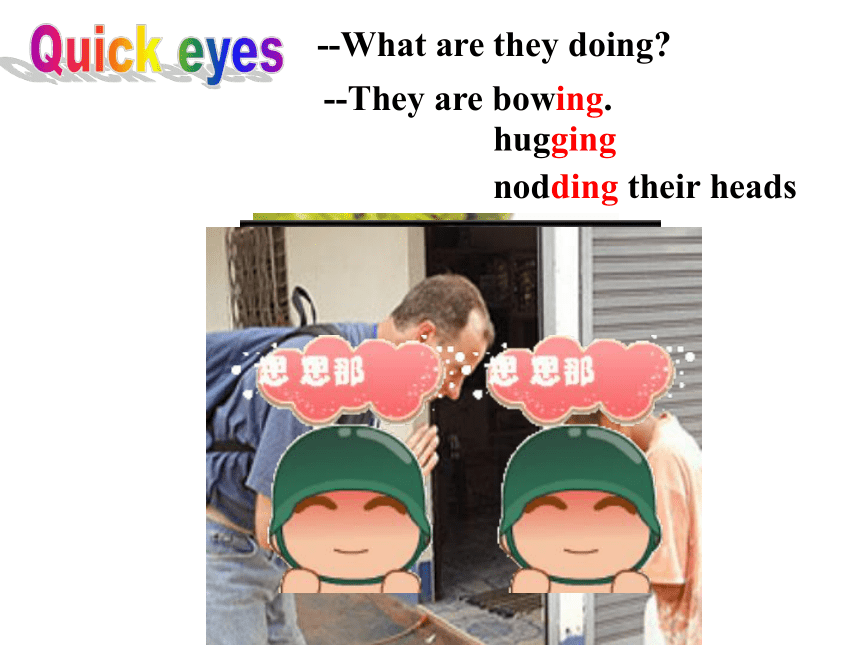
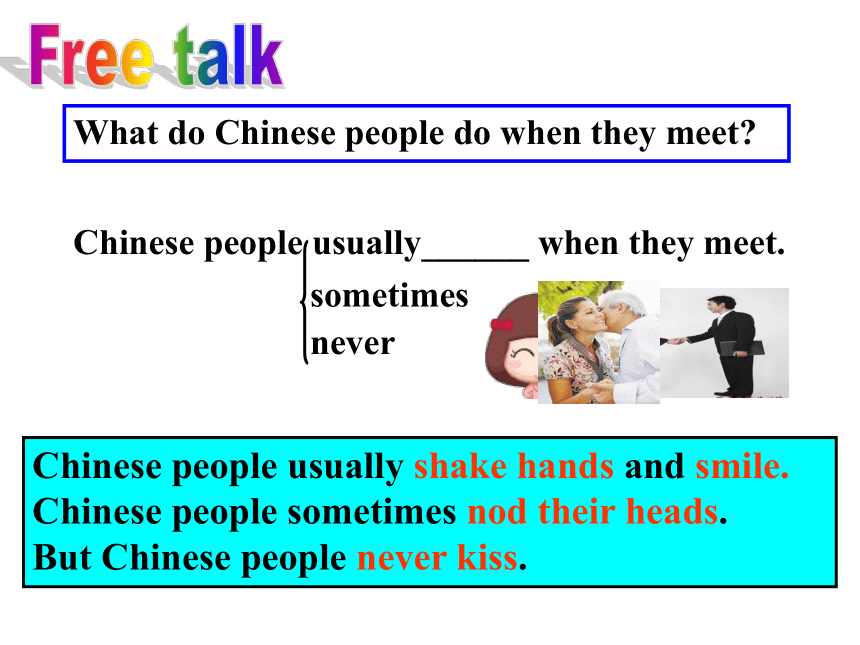
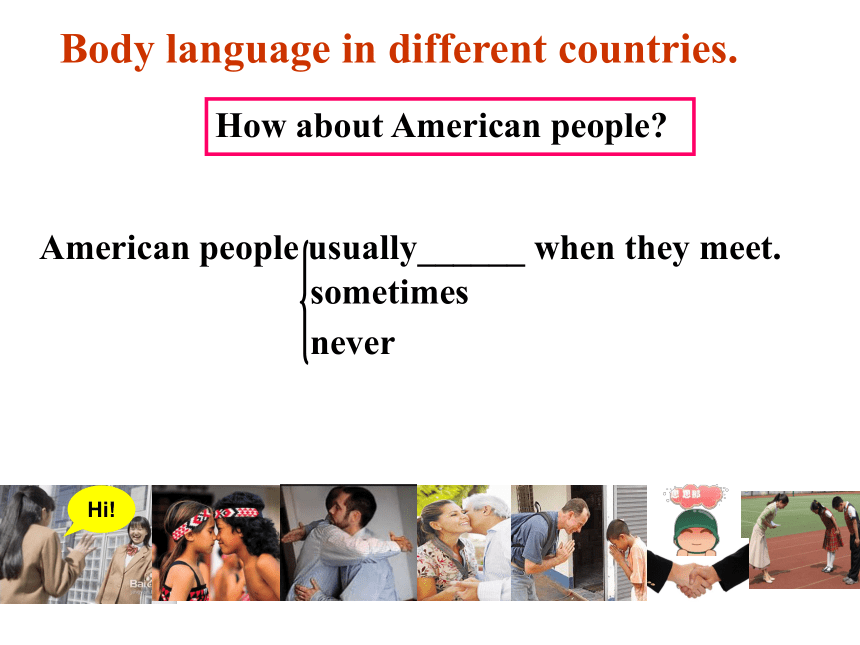
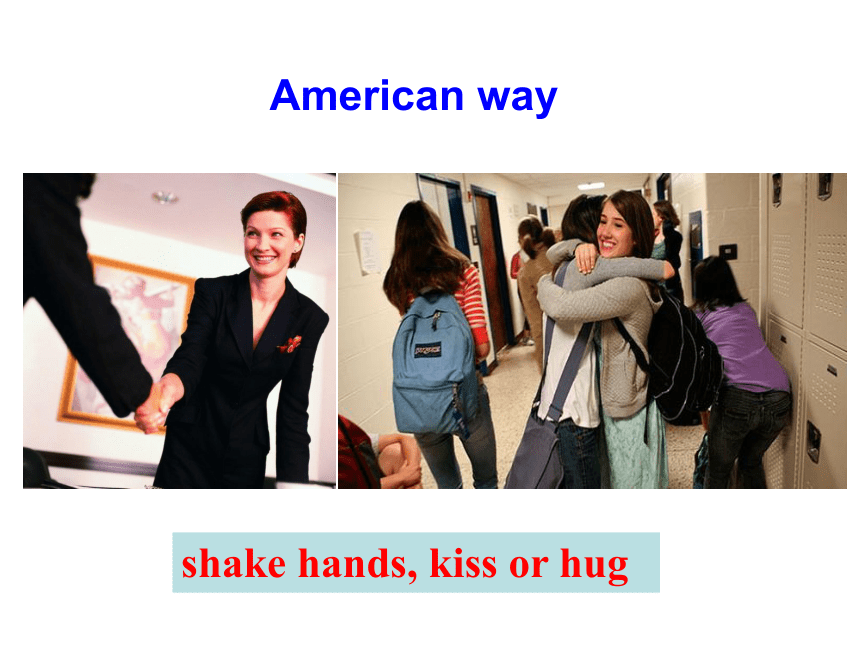
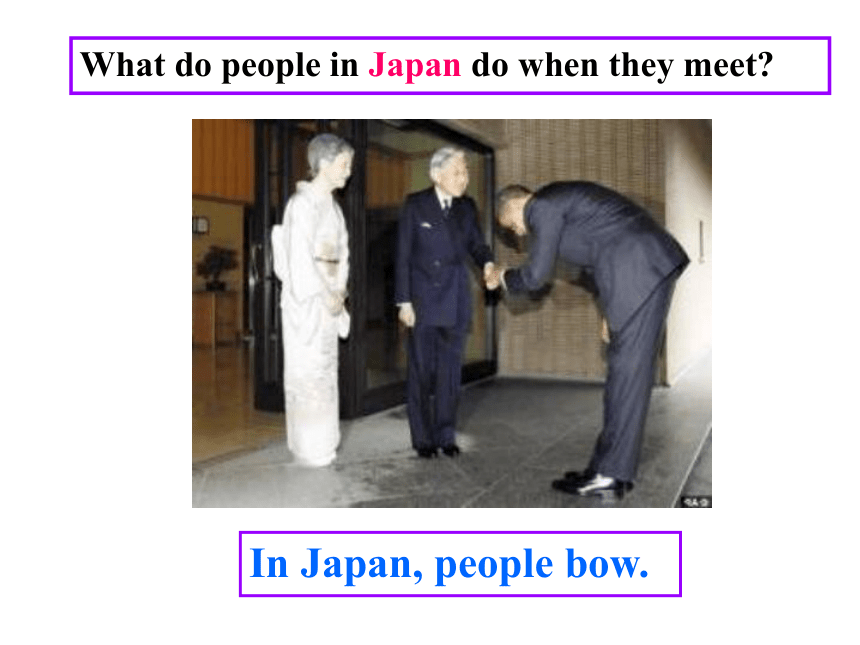
文档简介
(共29张PPT)
【学习目标】
能谈论不同国家的见面时的“body languages”
能用 “British, French, German, Japanese, Russian, Chinese, Indian”等表达他们的见面时的“body languages”
能用“bow, kiss, shake hands, smile, hug, touch noses, smile, put their hands together”等肢体语言来描述不同国家在见面时的肢体语言。
Unit 1 They touch noses.
( Listening & vocabulary )
Body language in our daily life
Be quiet!
Stop!
OK!
Great!
/Well done!
Goodbye!
This way, please!
Nod her head
Shake his head
Come on!
Give me five!
Smile.
Body language in our daily life
Be shy.
Body language of
greetings
b____
/a /
smile
k_ss
/ /
t__ch noses
/ /
h_g
/ /
put hands t_g_ther
n_d his head
/ /
/t 'ge /
sh_ke hands
/e /
ow
ou
u
i
o
a
o
e
--What are they doing
--They are bowing.
hugging
nodding their heads
What do Chinese people do when they meet
Chinese people usually______ when they meet.
never
sometimes
Chinese people usually shake hands and smile. Chinese people sometimes nod their heads.
But Chinese people never kiss.
How about American people
Hi!
Body language in different countries.
American people usually______ when they meet.
never
sometimes
American way
shake hands, kiss or hug
In Japan, people bow.
What do people in Japan do when they meet
How about Russian people
What do Russian people do when they meet
Read the new words fluently one by one.
Workbook(1) Module11 Unit1.
3.《100分闯关》Mofule11 Unit1.
【学习目标】
能谈论不同国家的见面时的“body languages”
能用 “British, French, German, Japanese, Russian, Chinese, Indian”等表达他们的见面时的“body languages”
能用“bow, kiss, shake hands, smile, hug, touch noses, smile, put their hands together”等肢体语言来描述不同国家在见面时的肢体语言。
Unit 1 They touch noses.
( Listening & reading )
various ways
of greeting
smile
shake hands
hug
wave
kiss
bow
People in different countries may use different body language to greet each other.
touch
nod
Chinese way
Shake hands and smile
American way
Shake hands, kiss or hug
President Xi
the US
/' nd /
/'r /
Russia
India
New Zealand
President Xi goes to many countries every year.
He goes to Russia and meets some Russian people.
India
Indian
New Zealand
Maori
/au/
shake hands
bow
kiss
touch noses
Put their
hands together
Learning to learn
People in different countries may use
different body language to express the
same meaning and feelings. When you
speak with people from other countries,
try to understand and respect their body
language.
That’s because it’s polite to do that!
Now complete the table with the correct form of the words from the box.
India kiss Russia together touch visitor
In China, people shake hands and smile.
When they meet _______.
American people shake hands and sometimes __________.
In ________, people put their hands _________ and nod their heads.
In ______, people kiss each other three times.
Maori people _______ noses.
India
kiss
Russia
together
touch
visitors
1. …in Russia, people usually kiss three times.
在俄罗斯,人们通常亲吻三次
Language points
“times” 在这里是可数名词,表示次数,
three times 表示 “三次”
在英文中,一次, once 两次, twice
三次以上都用“times”
Eg.My mother goes shopping once a week.
我妈妈每周购物一次。
How often does your mother go shopping
拓展:1.time—cn.时代,时期
Eg.The times are different today.当今的时代不同了、
2.time—un.时间,时刻
Eg.What time is it 几点了?
2.We Chinese often shake hands and smile.
(1)shake hands 表示“握手”。
Shake hands with sb. 表示“和某人握手”。
当我昨天遇到我的老板,我和他握手了。
When I met my boss yesterday,I shook hands with him.
(2)smile n.&v.微笑
smile at sb.对某人笑。She always smiles to everyone.
Smile: Laugh:
微笑,之无声的笑,种在表情,亲切,和蔼的,友好的 大笑,指出声的笑,常伴有动作,表示高兴、快乐、嘲笑。laugh at sb.嘲笑某人
3.Only parents and children do that。
只有父母和孩子能互相亲吻。
一、only是英语中出现频率很高的词,only用作形容词
1. 与the连用,意为“惟一的”。如:
John is the only boy in his family. 约翰是家里惟一的男孩。
2. only可修饰复数名词,意为“仅有的、惟一的一些”,
They were the only people present. 出席的只有他们这些人。
3. 与an连用,意为“单独的”。
Jim was an only son of his parents. 吉姆是他父母的独子。
4. 与the连用,意为“最好的、最适当的”。
The only thing to do on a hot day is to go swimming.
在热天最理想的事就是去游泳。
二、only用作副词
常位于所修饰的动词、短语或从句前,意为“只是、仅仅”。
I only touched it. 我只不过摸了它一下。
Parents and children only do that.
4. That’s because people do different things in different
countries.
那是因为不同国家的人们做法不同。
That’s because….. 是一个常用句式,表示 “那是因为……”,(后面接的是原因)其中,that 表示刚刚谈到的内容,注意,这里要用that,而不能用 this , 因为this 表示将要谈及的内容。That’s because you were not careful enough.
那是因为你不够仔细。
That’s because I didn’t know much about body language in this country.
那是因为我对这个国家的肢体语言了解不够。
Pairwork
What do you do and say when you meet your
teacher in the morning
I smile and say good morning.
A:
B:
● head teacher
● parents after school
● best friend
● favourite film star
● a visitor to your school
● an American
● a Russian
● ...
— What do you do and say when you
meet your teacher in the morning
— I smile and say good morning.
— What do you do and say when you
meet your parents after school
— Kiss and hug each other.
— What do you do and say when you
meet a Russian
— I smile, say hello and kiss each
other three times.
When in Rome, do as the Romas do!
( 入乡随俗 )
Homework
Read Activity3 after the tape.
Copy the new words of Page66 four times.
2. Workbook(2) Module11 Unit1(2).
Level A:
Level B:
Try to find out more traditional ways of different countries’ body language.
( 找出更多不同国家的传统的肢体语言。 )
【学习目标】
能谈论不同国家的见面时的“body languages”
能用 “British, French, German, Japanese, Russian, Chinese, Indian”等表达他们的见面时的“body languages”
能用“bow, kiss, shake hands, smile, hug, touch noses, smile, put their hands together”等肢体语言来描述不同国家在见面时的肢体语言。
Unit 1 They touch noses.
( Listening & vocabulary )
Body language in our daily life
Be quiet!
Stop!
OK!
Great!
/Well done!
Goodbye!
This way, please!
Nod her head
Shake his head
Come on!
Give me five!
Smile.
Body language in our daily life
Be shy.
Body language of
greetings
b____
/a /
smile
k_ss
/ /
t__ch noses
/ /
h_g
/ /
put hands t_g_ther
n_d his head
/ /
/t 'ge /
sh_ke hands
/e /
ow
ou
u
i
o
a
o
e
--What are they doing
--They are bowing.
hugging
nodding their heads
What do Chinese people do when they meet
Chinese people usually______ when they meet.
never
sometimes
Chinese people usually shake hands and smile. Chinese people sometimes nod their heads.
But Chinese people never kiss.
How about American people
Hi!
Body language in different countries.
American people usually______ when they meet.
never
sometimes
American way
shake hands, kiss or hug
In Japan, people bow.
What do people in Japan do when they meet
How about Russian people
What do Russian people do when they meet
Read the new words fluently one by one.
Workbook(1) Module11 Unit1.
3.《100分闯关》Mofule11 Unit1.
【学习目标】
能谈论不同国家的见面时的“body languages”
能用 “British, French, German, Japanese, Russian, Chinese, Indian”等表达他们的见面时的“body languages”
能用“bow, kiss, shake hands, smile, hug, touch noses, smile, put their hands together”等肢体语言来描述不同国家在见面时的肢体语言。
Unit 1 They touch noses.
( Listening & reading )
various ways
of greeting
smile
shake hands
hug
wave
kiss
bow
People in different countries may use different body language to greet each other.
touch
nod
Chinese way
Shake hands and smile
American way
Shake hands, kiss or hug
President Xi
the US
/' nd /
/'r /
Russia
India
New Zealand
President Xi goes to many countries every year.
He goes to Russia and meets some Russian people.
India
Indian
New Zealand
Maori
/au/
shake hands
bow
kiss
touch noses
Put their
hands together
Learning to learn
People in different countries may use
different body language to express the
same meaning and feelings. When you
speak with people from other countries,
try to understand and respect their body
language.
That’s because it’s polite to do that!
Now complete the table with the correct form of the words from the box.
India kiss Russia together touch visitor
In China, people shake hands and smile.
When they meet _______.
American people shake hands and sometimes __________.
In ________, people put their hands _________ and nod their heads.
In ______, people kiss each other three times.
Maori people _______ noses.
India
kiss
Russia
together
touch
visitors
1. …in Russia, people usually kiss three times.
在俄罗斯,人们通常亲吻三次
Language points
“times” 在这里是可数名词,表示次数,
three times 表示 “三次”
在英文中,一次, once 两次, twice
三次以上都用“times”
Eg.My mother goes shopping once a week.
我妈妈每周购物一次。
How often does your mother go shopping
拓展:1.time—cn.时代,时期
Eg.The times are different today.当今的时代不同了、
2.time—un.时间,时刻
Eg.What time is it 几点了?
2.We Chinese often shake hands and smile.
(1)shake hands 表示“握手”。
Shake hands with sb. 表示“和某人握手”。
当我昨天遇到我的老板,我和他握手了。
When I met my boss yesterday,I shook hands with him.
(2)smile n.&v.微笑
smile at sb.对某人笑。She always smiles to everyone.
Smile: Laugh:
微笑,之无声的笑,种在表情,亲切,和蔼的,友好的 大笑,指出声的笑,常伴有动作,表示高兴、快乐、嘲笑。laugh at sb.嘲笑某人
3.Only parents and children do that。
只有父母和孩子能互相亲吻。
一、only是英语中出现频率很高的词,only用作形容词
1. 与the连用,意为“惟一的”。如:
John is the only boy in his family. 约翰是家里惟一的男孩。
2. only可修饰复数名词,意为“仅有的、惟一的一些”,
They were the only people present. 出席的只有他们这些人。
3. 与an连用,意为“单独的”。
Jim was an only son of his parents. 吉姆是他父母的独子。
4. 与the连用,意为“最好的、最适当的”。
The only thing to do on a hot day is to go swimming.
在热天最理想的事就是去游泳。
二、only用作副词
常位于所修饰的动词、短语或从句前,意为“只是、仅仅”。
I only touched it. 我只不过摸了它一下。
Parents and children only do that.
4. That’s because people do different things in different
countries.
那是因为不同国家的人们做法不同。
That’s because….. 是一个常用句式,表示 “那是因为……”,(后面接的是原因)其中,that 表示刚刚谈到的内容,注意,这里要用that,而不能用 this , 因为this 表示将要谈及的内容。That’s because you were not careful enough.
那是因为你不够仔细。
That’s because I didn’t know much about body language in this country.
那是因为我对这个国家的肢体语言了解不够。
Pairwork
What do you do and say when you meet your
teacher in the morning
I smile and say good morning.
A:
B:
● head teacher
● parents after school
● best friend
● favourite film star
● a visitor to your school
● an American
● a Russian
● ...
— What do you do and say when you
meet your teacher in the morning
— I smile and say good morning.
— What do you do and say when you
meet your parents after school
— Kiss and hug each other.
— What do you do and say when you
meet a Russian
— I smile, say hello and kiss each
other three times.
When in Rome, do as the Romas do!
( 入乡随俗 )
Homework
Read Activity3 after the tape.
Copy the new words of Page66 four times.
2. Workbook(2) Module11 Unit1(2).
Level A:
Level B:
Try to find out more traditional ways of different countries’ body language.
( 找出更多不同国家的传统的肢体语言。 )
同课章节目录
- Module 1 Lost and found
- Unit 1 Whose bag is this?
- Unit 2 Are they yours?
- Unit 3 Language in use
- Module 2 What can you do ?
- Unit 1 I can play the piano
- Unit 2 I can run really fast
- Unit 3 Language in use
- Module 3 Making plans
- Unit 1 What are you going to do at the weekends?
- Unit 2 We're going to cheer the players.
- Unit 3 Language in use
- Module 4 Life in the future
- Unit 1 Everyone will study at home
- Unit 2 Every family will have a small plane.
- Unit 3 Language in use
- Module 5 Shopping
- Unit 1 What can I do for you?
- Unit 2 You can buy everything on the Internet
- Unit 3 Language in use
- Module 6 Around town
- Unit 1 Could you tell me how to get to the Nationa
- Unit 2 The London Eye is on your right.
- Unit 3 Language in use
- Revision module A
- Module 7 My past life
- Unit 1 I was born in a small village.
- Unit 2 I was born in Quincy.
- Unit 3 Language in use
- Module 8 Story time
- Unit 1 Once upon a time….
- Unit 2 Goldilocks hurried out of the house.
- Unit 3 Language in use
- Module 9 Life history
- Unit 1 He left school and began work at the age of
- Unit 2 He decided to be an actor.
- Unit 3 Language in use
- Module 10 A holiday journey
- Unit 1 What did you do?
- Unit 2 This morning we took a walk.
- Unit 3 Language in use
- Module 11 Body language
- Unit 1 They touch noses!
- Unit 2 Here are some ways to welcome them.
- Unit 3 Language in use
- Module 12 Western music
- Unit 1 It's so beautiful!
- Unit 2 Vienna is the centre of European classical
- Unit 3 Language in use
- Revision module B
